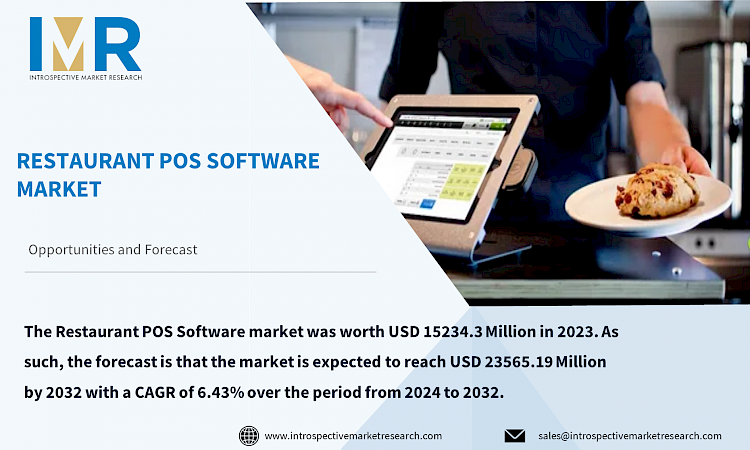
According to a new report published by Introspective Market Research, titled, “Restaurant POS Software Market by Component, Type, Operating System, Application, Enterprise Size Deployment Mode, Restaurant Type: Opportunity Analysis and Industry Forecast, 2024–2030,”
The Restaurant POS Software market was worth USD 15234.3 Million in 2023. As such, the forecast is that the market is expected to reach USD 23565.19 Million by 2032 with a CAGR of 6.43% over the period from 2024 to 2032.
The Restaurant POS (Point of Sale) Software market has been driven by the increasing adoption of digital solutions by restaurants worldwide. This market offers software systems designed specifically for managing various operations within a restaurant, including order processing, payment processing, inventory management, and customer relationship management.
The emergence of cloud-based POS solutions has revolutionized the market, offering scalability, flexibility, and accessibility to restaurant owners. Cloud-based POS systems allow restaurants to manage their operations from anywhere with an internet connection, making them particularly attractive for small and medium-sized businesses.
Advancements in technology, such as the integration of artificial intelligence and data analytics capabilities, are driving innovation in the Restaurant POS Software market. These technologies enable restaurants to gain valuable insights into customer behavior, optimize menu offerings, and personalize the dining experience.
Technology in the restaurant industry continues to develop rapidly and there is increasing demand for software designed specifically for restaurants-inventory control, table management systems, invoicing software or POS (point of sale) devices. All this bodes well for development of the market itself.
One recent development in order processing procedures has been that restaurant owners can simplify the taking of orders. The accompaniments Of course, this system also checks meal delivery dates and records the inventory.
Whenever there is less than two weeks’ worth of stock for a product, it automatically alerts users that are interested in placing an order to let them know how quickly needs may arise. This correlation is directly related to the restaurant's point-of-sale system. And it ensures that communication is done effectively and the kitchen can be operated in a sustainable manner.
Restaurant POS Software Market, Segmentation
The Restaurant POS Software market is segmented based on Component, Type, Operating System, Application, Enterprise Size, Deployment Mode and Restaurant Type
Deployment Type:
Concerns surrounding data security and compliance are effectively addressed through on-premises solutions, as sensitive customer and transaction data remain within the physical confines of the restaurant's premises. This provides a sense of assurance to both businesses and their patrons, especially in an era marked by increasing cybersecurity threats and regulatory scrutiny. For some restaurants, particularly those with limited or unreliable internet connectivity, on-premises solutions represent a more reliable option, ensuring uninterrupted service and transactions even in offline scenarios.
Application:
Inventory management is critical for restaurants to control costs, minimize waste, and ensure consistent supply of ingredients. POS software equipped with robust inventory management features enables restaurant owners to track stock levels, monitor ingredient usage in real-time, and automate reordering processes. By efficiently managing inventory, restaurants can optimize stock levels, reduce overstocking or stockouts, and prevent food spoilage, leading to significant cost savings. Moreover, integrated inventory management streamlines operations by synchronizing inventory data with sales transactions, simplifying accounting processes and enhancing accuracy.
Region:
North America is poised to dominate the restaurant POS (Point of Sale) software market for several compelling reasons. Firstly, the region boasts a robust and mature restaurant industry, comprising a diverse array of establishments ranging from quick-service eateries to fine dining restaurants. This diversity creates a substantial demand for POS solutions tailored to varying operational needs. North America has a high adoption rate of technology in the restaurant sector, driven by a combination of factors such as efficiency demands, customer preferences, and regulatory compliance. This inclination towards technological solutions extends to POS software, which enables restaurants to streamline operations, enhance customer experiences, and gather valuable data for business insights.
Some of The Leading/Active Market Players Are-
- Oracle (U.S.)
- Infor. (U.S.)
- Toshiba Tec Corporation (Japan)
- SpotOn Transact, LLC (U.S.)
- Clover Network, Inc. (U.S.)
- Epos Now (U.K.)
- eZee BurrP! (India)
- Future POS. (U.S.), Other Active players
Key Industry Developments: -
- In January 2024, ParTech, Inc., restaurant POS provider, launched the PAR Wave - an All-In-One touch panel designed for hardware component for the hospitality industry. PAR's Wave combines performance, security, functionality, and new design to meet the demands of the restaurant industry.
- In August 2023, Snack POS, restaurant point of sale system provider, partnered with PAX, provider of secure electronic payment terminal solutions to launch Europay, MasterCard, and Visa (EMV) enabled terminals to restaurants, securing payment and convenience for both customers and businesses.
- In May 2023, Toast, Inc., restaurant POS provider, partnered with Deliverect, a provider of solutions that help simplify online orders from food delivery businesses into the POS systems of restaurants. Through this partnership, Deliverect aimed to use the Toast Partner Ecosystem to enable restaurants to manage online orders from their Toast POS systems with enhanced flexibility and ease.
Key Findings of the Study
- The market is experiencing significant growth driven by the widespread adoption of cloud-based POS systems. These solutions offer scalability, flexibility, and accessibility, particularly benefiting small and medium-sized restaurants. Cloud-based POS systems enable restaurant owners to manage operations remotely, contributing to increased efficiency and reduced operational costs.
- Advancements in technology, including artificial intelligence and data analytics, are driving innovation in the restaurant POS software market. These technologies empower restaurants to gain valuable insights into customer behavior, optimize menu offerings, and personalize the dining experience. The integration of AI and data analytics capabilities enhances operational efficiency and enables data-driven decision-making, thereby improving overall business performance.




